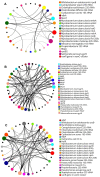Characterization of antibiotic resistance genes in soils from agroecosystems of the Brazilian Amazon
- PMID: 40497053
- PMCID: PMC12149118
- DOI: 10.3389/fmicb.2025.1508157
Characterization of antibiotic resistance genes in soils from agroecosystems of the Brazilian Amazon
Abstract
The conversion of forests to pastureland in the Amazon has increased over the years, resulting in significant impacts on ecosystem diversity, particularly on the soil microbiota. These changes affect the physical and biological properties of the soil, influencing the resistome and contributing to the selection and spread of antibiotic resistance genes (ARGs) in the soil environment. This study aimed to analyze the soil resistome under different managements in an Amazonian agrosystem. Soil samples were collected from the organic layer in forest and pasture areas within the municipality of São Miguel do Guamá, which included pastures managed with fertilization and those without the use of fertilizers. The samples underwent processing to extract genetic material and were sequenced using the Illumina platform. The sequences obtained were analyzed using bioinformatics tools to identify bacterial taxonomy and diversity. In addition, genetic annotation was performed using specialized databases to characterize functional genes, mobile elements, and resistance genes. The results showed changes in bacterial composition in pasture soils, where species such as Staphylococcus aureus, Staphylococcus cohnii, and Bacillus coagulans were more prevalent. In forest soils, differences in the composition of functional genes were detected, while soils without fertilizers exhibited a higher abundance of transposable elements. In addition, antibiotic resistance genes, such as macrolides, tetracyclines, aminoglycosides, among others, were more abundant in pasture soils.
Keywords: antibiotic resistance genes; bacterial diversity; mobile genetic elements; native forest; pasture soils.
Copyright © 2025 Tavares, Pinto, Cardenas-Alegria, Dantas, Silva, Ribeiro Cruz, do Rêgo, Rogez, Ramos, Faturi and Nunes.
Conflict of interest statement
The authors declare that the research was conducted in the absence of any commercial or financial relationships that could be construed as a potential conflict of interest.
Figures







References
-
- Alcock B. P., Huynh W., Chalil R., Smith K. W., Raphenya A. R., Wlodarski M. A., et al. (2023). CARD 2023: expanded curation, support for machine learning, and resistome prediction at the comprehensive antibiotic resistance database. Nucleic Acids Res. 51, 690–699. 10.1093/nar/gkac920 - DOI - PMC - PubMed
-
- Almeida M. L., Almeida M. L., Nery K. L. D. F. B., De Melo D. S., Da Cruz A. S., Fortes A. B. P. L., et al. (2023). Resistência bacteriana: uma ameaça global. Braz. J. Hea. Rev. 6, 19741–19748. 10.34119/bjhrv6n5-028 - DOI
LinkOut - more resources
Full Text Sources

